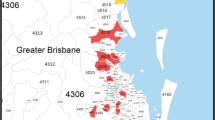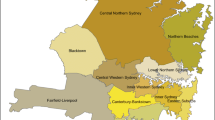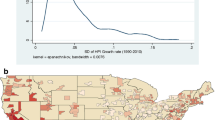Abstract
Housing data from the last 25 years show that returns to residential real estate in the U.S. can be volatile and vary significantly among locations. The variations in returns are driven by economically as well as geographically and psychologically motivated factors, but so far, no asset pricing model that adequately explains systematic risks in cross-sectional housing returns is widely accepted. This paper proposes an asset pricing model for housing returns that includes a market-wide return factor, an economically motivated factor derived from income growth, a geographically based factor derived from land supply elasticity and a momentum factor, which is psychological in nature. The model explains well the systematic risks in housing returns and is robust to different portfolio segmentations. Moreover, the model illustrates that local risk factors indirectly capture the risk previously attributed to market-wide price changes. While housing is not actively traded when compared to other financial assets, understanding the risk-factors that explain housing return in cross-section provides important insight for real estate investors, builders, real estate future traders, homeowners, banks and other mortgage lenders.






Similar content being viewed by others
Notes
Gyourko et al. (2006) argue that housing appreciation in a few “superstar” cities may exceed the national income growth for extended time periods mainly due to growth in high-income population in these cities.
Beracha and Skiba (2011) show that portfolios based on performance from the previous four quarters experience the highest level of return momentum.
The index data are available at http://www.fhfa.gov.
FHFA defines a repeated sale when the same physical address originates at least two mortgages and those mortgages are purchased by either Freddie Mac or Fannie Mae. The use of repeated sales of the same physical address controls for properties’ characteristics, and reduces the effect of changes in construction quality over time on changes in housing prices. For more detail about the index construction see Calhoun (1996) and OFHEO’s website at http://www.fhfa.gov.
For the complete list of MSA land supply elasticities, see Saiz (2008).
References
Albouy, D. (2009). What are cities worth? Land rents, local productivity, and the capitalization of amenity values. NBER Working Paper 14981.
Beltratti, A., & Morana, C. (2010). International house prices and macroeconomic fluctuations. Journal of Banking and Finance, 34(3), 533–545.
Beracha, E., & Skiba, H. (2011). Momentum in residential real estate. Journal of Real Estate Finance and Economics, 43(3), 299–320.
Calhoun, C. A. (1996). OFHEO house price indices: HPI technical description. Federal Housing Finance Agency. http://www.fhfa.gov/. Accessed October 2010.
Cannon, S., Miller, N. G., & Pandher, G. (2006). Risk and return in the U.S. housing market: A cross-sectional asset pricing approach. Real Estate Economics, 34(4), 519–552.
Capozza, D. R., Hendershott, P. H., & Mack, C. (2004). An anatomy of price dynamics in illiquid markets: Analysis and evidence from local housing markets. Real Estate Economics, 32(1), 1–32.
Carhart, M. (1997). On persistence of mutual fund performance. Journal of Finance, 52(1), 57–82.
Case, K., Cotter, J., & Gabriel, S. (2011). Housing risk and return: Evidence from a housing asset-pricing model. Journal of Portfolio Management, 35(5), 89–109.
Case, K. E., & Shiller, R. J. (1989). The efficiency of the market for single-family homes. American Economic Review, 79(1), 125–137.
Case, K. E., & Shiller, R. J. (1990). Forecasting prices and excess returns in the housing market. Real Estate Economics, 18(3), 253–273.
Case, K. E., & Shiller, R. J. (2003). Is there a bubble in the housing market? Brookings Papers on Economic Activity, 2, 299–342.
Chen, N., & Leung, C. K. (2008). Asset price spillover, collateral and crises: with an application to property market policy. Journal of Real Estate Finance and Economics, 37(4), 351–385.
Chui, A. C. W., Titman, S., & Wei, K. C. J. (2010). Individualism and momentum around the world. Journal of Finance, 65(1), 361–392.
Clayton, J. (1996). Rational expectations, market fundamentals and housing price volatility. Real Estate Economics, 24(4), 441–470.
Costello, G., Fraser, P., & Groenewold, N. (2011). House prices, non-fundamental components and interstate spillovers: The Australian experience. Journal of Banking and Finance, 35(3), 653–669.
Daniel, K., Hirshleifer, D., & Subrahmanyam, A. (1998). Investor psychology and security market under- and overreactions. Journal of Finance, 53(6), 1839–1886.
Derwall, J., Huij, J., Brounen, D., & Marquering, W. (2009). REIT momentum and the performance of real estate mutual funds. Financial Analyst Journal, 65(5), 24–34.
Fama, E. F., & French, K. R. (1992). The cross-section of expected stock returns. Journal of Finance, 47(2), 427–465.
Fama, E. F., & French, K. R. (1993). Common risk-factors in the returns on stocks and bonds. Journal of Financial Economics, 33(1), 3–56.
Gervais, S., & Odean, T. (2001). Learning to be overconfident. Review of Financial Studies, 14(1), 1–27.
Glaeser, E. L. & Gyourko, J. (2006). Housing dynamics. NBER Working Paper 12787.
Glaeser, E. L., Gyourko, J., & Saiz, A. (2008). Housing supply and housing bubbles. Journal of Urban Economics, 64(2), 198–214.
Gyourko, J., Mayer, C., & Sinai, T. (2006). Superstar cities. NBER Working Paper No. W12355.
Jegadeesh, N., & Titman, S. (1993). Returns to buying winners and selling losers: implications for stock market efficiency. Journal of Finance, 48(1), 65–91.
Jensen, M. C. (1969). Risk, the pricing of capital assets, and the evaluation of investment portfolios. Journal of Business, 42(2), 167–247.
Koetter, M., & Poghosyan, T. (2010). Real estate prices and bank stability. Journal of Banking and Finance, 34(6), 1129–1138.
Lintner, J. (1965). The valuation of risk assets and the selection of risky investments in stock portfolios and capital budgets. Review of Economics and Statistics, 47(1), 13–37.
Miller, N., Peng, L., & Sklarz, M. (2011). House prices and economic growth. Journal of Real Estate Finance and Economics, 42(4), 522–541.
Naranjo, A., & Ling, C. (1997). Economic risk factors and commercial real estate returns. Journal of Real Estate Finance and Economics, 15(3), 283–307.
Pais, A., & Stork, P. A. (2011). Contagion risk in the Australian banking and property sectors. Journal of Banking and Finance, 35(3), 681–697.
Piazzesi, M., & Schneider, M. (2009). Momentum traders in the housing market: Survey evidence and a search model. American Economic Review, 99(2), 406–411.
Saiz, A. (2008). On local housing supply elasticity. Working paper.
Sharpe, W. F. (1964). Capital asset prices: A theory of market equilibrium under conditions of risk. Journal of Finance, 19(3), 425–442.
Shiller, R. J. (2007). Understanding recent trends in house prices and home ownership. NBER Working Paper.
Sommervoll, D. E., Borgersen, T., & Wennemo, T. (2010). Endogenous housing market cycles. Journal of Banking and Finance, 34(3), 557–567.
Author information
Authors and Affiliations
Corresponding author
Rights and permissions
About this article
Cite this article
Beracha, E., Skiba, H. Findings from a Cross-Sectional Housing Risk-Factor Model. J Real Estate Finan Econ 47, 289–309 (2013). https://doi.org/10.1007/s11146-011-9360-x
Published:
Issue Date:
DOI: https://doi.org/10.1007/s11146-011-9360-x




